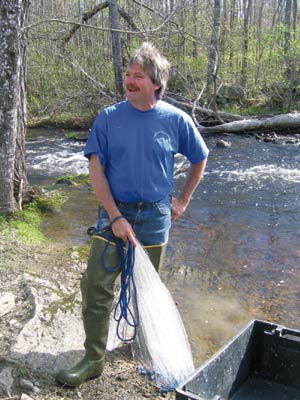 David Pierce estimates that the alewife fishery supports over 400 jobs, and it is those jobs he was in D.C. fighting for just a few days earlier. “We asked that the ASMFC separate alewives and blueback herring out of the shad management plan. If we stay under their plan, we’ll be all done. They are that close to shutting down the fishery.” Catherine Schmitt photo David Pierce estimates that the alewife fishery supports over 400 jobs, and it is those jobs he was in D.C. fighting for just a few days earlier. “We asked that the ASMFC separate alewives and blueback herring out of the shad management plan. If we stay under their plan, we’ll be all done. They are that close to shutting down the fishery.” Catherine Schmitt photo
|
“I’ve had too much taken away from me in this state,” he said. “After that meeting, I called DMR and got the list of towns [with alewife harvesting rights] and tracked down all the harvesters.” The perceived threat of a moratorium was great enough to prod the small number of fishermen working the roughly 30 remaining commercial harvests scattered along the coast of Maine into getting together.
In March, alewife harvesters mingled among the more familiar faces at the Fishermen’s Forum. Pierce said that they were advocating for the status quo in the ASMFC plan, which would allow the state of Maine to continue to regulate the fishery, and asked alewife fishermen to come talk to him. Almost every harvester in the state came out to the group’s first meeting in early April, said Pierce.
Like all alewife harvesters in Maine, Pierce takes three days off to allow the fish to run free, another two miles upstream to their spawning grounds in 337-acre Dresden Bog.
The old sawmill, mill pond, sluiceways, and brickyard are gone, but the fish have returned. “This stream has been fished for alewives forever,” said Pierce, “even after World War I, guys would take off to go fishing. It was a staple.”
After the few people who still eat alewives “pick out the smokers,” the harvest is used as bait in the lobster fishery.
Pierce figures that on average they take about ten percent of the alewives in Mill Stream. “They” are the guys he has working for him; guys like Charlie, who, still tired from taking a load of fish out to Criehaven at midnight, sat in his truck drinking coffee, watching eagles circle above the stream while the rest of the world came to life.
Pierce estimates that the alewife fishery supports over 400 jobs, and it is those jobs he was in D.C. fighting for just a few days earlier. “We asked that the ASMFC separate alewives and blueback herring out of the shad management plan. If we stay under their plan, we’ll be all done. They are that close to shutting down the fishery.”
As vocal as Pierce is, he is the first to admit he would rather be working at his construction business than be in D.C. But he’d rather be at the alewife run than either of those places, and so he helped organize his fellow harvesters into presenting their own management plan to Washington. Erika Robbins of the ASMFC said that having an organization like AHM makes it easier for fishermen to become engaged in the process. “We’ve managed river herring since 1985,” she said, “but our management has been very simple. This is the first time we are considering making major changes.” The next stock assessment is not due until 2012. In the meantime, ASMFC admits they do not have enough information about the hundreds of harvests along the East Coast, and data collection continues. The draft Amendment 2 will be available for public comment later this summer or early fall.
As Pierce sees it, harvesting is keeping the fishery alive, and having a fishery keeps the fish alive in society’s collective consciousness and provides incentive to improve habitat. And so he also is an enthusiastic partner in a research project to identify the role of alewives in coastal food webs. Biological information and scales are taken from some fish, and others are tagged. The team, led by Theodore Willis of the University of Southern Maine Aquatic Systems Group and partially funded by Sea Grant, plans to tag 10,000 fish. “The research helps our cause with ASMFC,” said Pierce.
“Jeff wanted to know if his fish were indeed returning to his stream, and I wanted to get some numbers on mortality and homing,” said Willis. “We are working with all of the harvesters and fishways around Merrymeeting Bay. I serve as a science advisor, helping coordinate more efforts like the one underway in Dresden. Many of the harvesters are curious about the behavior and biology of their fish. They have theories based on years of observation. I have a sense of the type of information managers are looking for to improve their management of alewives. Where it makes sense, I work with harvesters to test their theories and formalize that local knowledge for consumption by managers.”
And one more thing, about that name. Pierce said that he and his fellow harvesters are “trying to get out from under the stigma of the name river herring,” a collective term for sea-run fish in the genus Alosa, which includes alewives, blueback herring, American shad, and hickory shad. “The Atlantic States Marine Fisheries Commission is combining all of these species under one management plan. Two of these species are not doing well in the southern states, but the alewives and the blueback herring are doing well in northern regions of the East Coast,” said Pierce.
|





